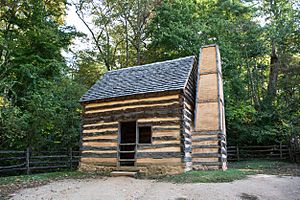Sarah Johnson (Mount Vernon) facts for kids
Sarah Johnson (born September 29, 1844 – died January 25, 1920) was an African American woman. She was born into slavery at Mount Vernon, which was George Washington's home in Fairfax, Virginia. Sarah worked there as a housekeeper, cleaning and taking care of the mansion. Over time, she learned a lot about all the furniture and items in the house, becoming like an unofficial historian of the place.
After the American Civil War ended, Sarah Johnson was hired by the Mount Vernon Ladies' Association. This group worked to preserve Mount Vernon. She eventually became a council member of the organization. Sarah even bought four acres of land at Mount Vernon to start her own small farm. Her life story, and the lives of many others who lived at Mount Vernon, are told in the book Sarah Johnson's Mount Vernon (published in 2008).
Contents
Life at Mount Vernon

When George Washington died in 1799, 316 enslaved people lived at Mount Vernon. About half of them were owned by Washington himself. The other half were inherited by Martha Washington's children from her first husband, Daniel Parke Custis.
George Washington wanted to free the people he enslaved after his death. However, his will only freed his personal manservant, William Lee, right away. The rest were to be freed after Martha Washington died. Martha decided to free the people she fully owned on New Year's Day in 1801. After her death in 1802, the remaining enslaved people were divided among her four grandchildren. Some stayed at Mount Vernon, while others moved to different estates.
Sarah Johnson's ancestors were among the enslaved people brought to Mount Vernon by the family who inherited the plantation. Bushrod Washington, George Washington's nephew, inherited Mount Vernon after Martha's death. He freed the enslaved people his uncle owned, as required by the will. But he also brought enslaved people he had inherited from his own parents. This meant both enslaved and freed Black people lived on the estate.
Bushrod Washington later sold some enslaved people. This caused a lot of discussion and controversy at the time. Some enslaved people also tried to escape.
Changes in Ownership
In 1829, Bushrod Washington and his wife passed away without children. His nephew, John Augustine Washington II, inherited Mount Vernon. He also owned another plantation called "Blakeley." John Augustine Washington II died within three years. His wife, Jane Charlotte Blackburn Washington, then managed both estates.
Sarah's mother, Hannah Parker, was born around 1826 at Blakeley. Jane Charlotte Washington often moved enslaved people between her plantations. In 1841, Jane Charlotte Washington decided to live at Blakeley. She leased Mount Vernon and some enslaved people to her oldest son, John Augustine Washington III. He was the first Washington family member to personally manage Mount Vernon since George Washington.
Augustine Washington brought Hannah Parker and other workers to Mount Vernon. He worked to improve the farm. He also leased out enslaved people, including Hannah Parker. Augustine Washington became the full owner of Mount Vernon in 1855. He tried to sell it to the state of Virginia and the U.S. government, but he was not successful. By this time, Mount Vernon was showing a lot of wear from many visitors and the farm was not doing well. Eventually, Augustine Washington moved his family and some enslaved people to another plantation.
Preserving Mount Vernon
The Mount Vernon Ladies' Association bought part of Mount Vernon in 1859. They wanted to save the plantation, especially as the American Civil War was approaching. Black people who worked at Mount Vernon also wanted to preserve the estate. But their main goal was to gain their own freedom. They wanted to be able to buy their own property, choose their own jobs, and plan for their futures.
When Mount Vernon opened to visitors, there were certain expectations for how Black workers should behave. They were expected to act in a way that showed they were loyal and obedient. African Americans did many different jobs on the plantation. They worked as cooks, servants, and farm hands. Sarah Johnson's uncle, Edmund Parker, was the last person in her family to be a guardian of George Washington's tomb. Other Black men had held this important role before him.
Early Life and Family
Sarah Johnson was born on September 29, 1844. Her mother was Hannah Parker, a teenage girl who was enslaved by Jane Charlotte Washington. Hannah was sent to Mount Vernon, which was managed by Augustine Washington. Augustine Washington later sold the property to the Mount Vernon Ladies' Association during Sarah's lifetime.
Sarah's mother, Hannah, had given birth to a son named Isaac in 1842. About two years after Sarah was born, her mother married Warner May. Augustine Washington bought Warner May from another estate. Hannah and Warner had five more children together. So, Sarah had several half-siblings. The name of Sarah's father is not known.
Sarah Johnson first married Nathan Johnson, who was also enslaved at Mount Vernon. They had a son named Smith, born in 1861.
On October 25, 1888, Sarah married a second time to William Robinson. He was a widower and one of the most important Black landowners in the area. He owned about fifty acres of land. William Robinson also worked part-time for the Mount Vernon Ladies' Association. Their wedding was a simple ceremony held at Sarah's house at Mount Vernon.
Working at Mount Vernon
Sarah Johnson worked as a housekeeper and caretaker at Mount Vernon for more than 50 years. She lived there first as an enslaved girl. Later, she gained her freedom.
After the Civil War, the Mount Vernon Ladies' Association hired Sarah Johnson. She did household chores, kept the house tidy, and sold lunches to visitors. Her co-workers and the leaders of the Association respected her greatly. She was known for knowing the history of almost every piece of furniture in the mansion.
Sarah and her first husband, Nathan, ran a lunchroom. They served meals to tradesmen who stayed at Mount Vernon. She earned sixty cents a day for each person. She also sold a history book about the estate and official guidebooks for a few cents each. After working at Mount Vernon for forty years, she became a council member of the Mount Vernon Ladies' Association.
In 1889, Sarah bought a four-acre piece of land and a farmhouse in the middle of the Mount Vernon property. She paid $350 for it. This land was in a good location, near a planned railroad route. Later, part of her land was taken by Fairfax County to build a road. She also sold other parts of her land over the next thirty years when she faced financial difficulties in her old age.
Death and Legacy
Sarah Johnson passed away at Freedman's Hospital in Washington D.C. on January 25, 1920. Mount Vernon lowered its flag to half-mast to honor her memory.
Almost a century after her death, historian Scott E. Casper wrote a book about her life. The book is called Sarah Johnson's Mount Vernon. It also tells the stories of other enslaved people after George Washington's death. The book uses old records, letters, newspapers, and ledgers to share the experiences of African Americans who lived and worked at Mount Vernon. It covers their lives during and after slavery, through important times like the Civil War and the Reconstruction era.
The book shows the contrast between the founding of the United States, with its noble goals, and the reality of slavery and unfair treatment of Black people. As one reviewer said, "Mount Vernon was a far more complicated place for black residents than for whites, because it represented three fundamentals that blacks were constantly trying to establish: work, home and a sense of national pride."
See also




